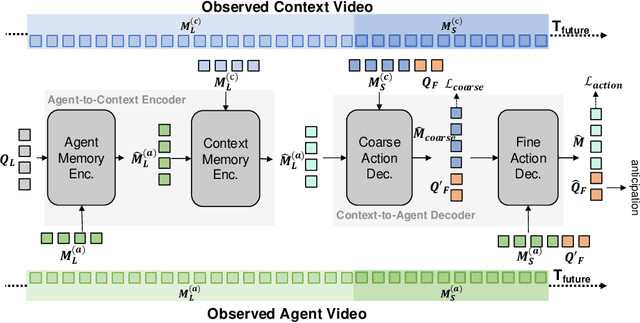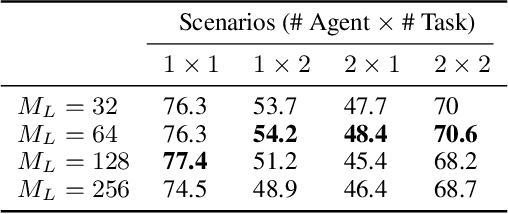Simon Stepputtis
ONLY: One-Layer Intervention Sufficiently Mitigates Hallucinations in Large Vision-Language Models
Jul 01, 2025Abstract:Recent Large Vision-Language Models (LVLMs) have introduced a new paradigm for understanding and reasoning about image input through textual responses. Although they have achieved remarkable performance across a range of multi-modal tasks, they face the persistent challenge of hallucination, which introduces practical weaknesses and raises concerns about their reliable deployment in real-world applications. Existing work has explored contrastive decoding approaches to mitigate this issue, where the output of the original LVLM is compared and contrasted with that of a perturbed version. However, these methods require two or more queries that slow down LVLM response generation, making them less suitable for real-time applications. To overcome this limitation, we propose ONLY, a training-free decoding approach that requires only a single query and a one-layer intervention during decoding, enabling efficient real-time deployment. Specifically, we enhance textual outputs by selectively amplifying crucial textual information using a text-to-visual entropy ratio for each token. Extensive experimental results demonstrate that our proposed ONLY consistently outperforms state-of-the-art methods across various benchmarks while requiring minimal implementation effort and computational cost. Code is available at https://github.com/zifuwan/ONLY.
InstructPart: Task-Oriented Part Segmentation with Instruction Reasoning
May 23, 2025Abstract:Large multimodal foundation models, particularly in the domains of language and vision, have significantly advanced various tasks, including robotics, autonomous driving, information retrieval, and grounding. However, many of these models perceive objects as indivisible, overlooking the components that constitute them. Understanding these components and their associated affordances provides valuable insights into an object's functionality, which is fundamental for performing a wide range of tasks. In this work, we introduce a novel real-world benchmark, InstructPart, comprising hand-labeled part segmentation annotations and task-oriented instructions to evaluate the performance of current models in understanding and executing part-level tasks within everyday contexts. Through our experiments, we demonstrate that task-oriented part segmentation remains a challenging problem, even for state-of-the-art Vision-Language Models (VLMs). In addition to our benchmark, we introduce a simple baseline that achieves a twofold performance improvement through fine-tuning with our dataset. With our dataset and benchmark, we aim to facilitate research on task-oriented part segmentation and enhance the applicability of VLMs across various domains, including robotics, virtual reality, information retrieval, and other related fields. Project website: https://zifuwan.github.io/InstructPart/.
Spectral-Aware Global Fusion for RGB-Thermal Semantic Segmentation
May 21, 2025Abstract:Semantic segmentation relying solely on RGB data often struggles in challenging conditions such as low illumination and obscured views, limiting its reliability in critical applications like autonomous driving. To address this, integrating additional thermal radiation data with RGB images demonstrates enhanced performance and robustness. However, how to effectively reconcile the modality discrepancies and fuse the RGB and thermal features remains a well-known challenge. In this work, we address this challenge from a novel spectral perspective. We observe that the multi-modal features can be categorized into two spectral components: low-frequency features that provide broad scene context, including color variations and smooth areas, and high-frequency features that capture modality-specific details such as edges and textures. Inspired by this, we propose the Spectral-aware Global Fusion Network (SGFNet) to effectively enhance and fuse the multi-modal features by explicitly modeling the interactions between the high-frequency, modality-specific features. Our experimental results demonstrate that SGFNet outperforms the state-of-the-art methods on the MFNet and PST900 datasets.
Model-Agnostic Policy Explanations with Large Language Models
Apr 08, 2025Abstract:Intelligent agents, such as robots, are increasingly deployed in real-world, human-centric environments. To foster appropriate human trust and meet legal and ethical standards, these agents must be able to explain their behavior. However, state-of-the-art agents are typically driven by black-box models like deep neural networks, limiting their interpretability. We propose a method for generating natural language explanations of agent behavior based only on observed states and actions -- without access to the agent's underlying model. Our approach learns a locally interpretable surrogate model of the agent's behavior from observations, which then guides a large language model to generate plausible explanations with minimal hallucination. Empirical results show that our method produces explanations that are more comprehensible and correct than those from baselines, as judged by both language models and human evaluators. Furthermore, we find that participants in a user study more accurately predicted the agent's future actions when given our explanations, suggesting improved understanding of agent behavior.
Self-Correcting Decoding with Generative Feedback for Mitigating Hallucinations in Large Vision-Language Models
Feb 10, 2025Abstract:While recent Large Vision-Language Models (LVLMs) have shown remarkable performance in multi-modal tasks, they are prone to generating hallucinatory text responses that do not align with the given visual input, which restricts their practical applicability in real-world scenarios. In this work, inspired by the observation that the text-to-image generation process is the inverse of image-conditioned response generation in LVLMs, we explore the potential of leveraging text-to-image generative models to assist in mitigating hallucinations in LVLMs. We discover that generative models can offer valuable self-feedback for mitigating hallucinations at both the response and token levels. Building on this insight, we introduce self-correcting Decoding with Generative Feedback (DeGF), a novel training-free algorithm that incorporates feedback from text-to-image generative models into the decoding process to effectively mitigate hallucinations in LVLMs. Specifically, DeGF generates an image from the initial response produced by LVLMs, which acts as an auxiliary visual reference and provides self-feedback to verify and correct the initial response through complementary or contrastive decoding. Extensive experimental results validate the effectiveness of our approach in mitigating diverse types of hallucinations, consistently surpassing state-of-the-art methods across six benchmarks. Code is available at https://github.com/zhangce01/DeGF.
HiMemFormer: Hierarchical Memory-Aware Transformer for Multi-Agent Action Anticipation
Nov 03, 2024



Abstract:Understanding and predicting human actions has been a long-standing challenge and is a crucial measure of perception in robotics AI. While significant progress has been made in anticipating the future actions of individual agents, prior work has largely overlooked a key aspect of real-world human activity -- interactions. To address this gap in human-like forecasting within multi-agent environments, we present the Hierarchical Memory-Aware Transformer (HiMemFormer), a transformer-based model for online multi-agent action anticipation. HiMemFormer integrates and distributes global memory that captures joint historical information across all agents through a transformer framework, with a hierarchical local memory decoder that interprets agent-specific features based on these global representations using a coarse-to-fine strategy. In contrast to previous approaches, HiMemFormer uniquely hierarchically applies the global context with agent-specific preferences to avoid noisy or redundant information in multi-agent action anticipation. Extensive experiments on various multi-agent scenarios demonstrate the significant performance of HiMemFormer, compared with other state-of-the-art methods.
LogiCity: Advancing Neuro-Symbolic AI with Abstract Urban Simulation
Nov 01, 2024



Abstract:Recent years have witnessed the rapid development of Neuro-Symbolic (NeSy) AI systems, which integrate symbolic reasoning into deep neural networks. However, most of the existing benchmarks for NeSy AI fail to provide long-horizon reasoning tasks with complex multi-agent interactions. Furthermore, they are usually constrained by fixed and simplistic logical rules over limited entities, making them far from real-world complexities. To address these crucial gaps, we introduce LogiCity, the first simulator based on customizable first-order logic (FOL) for an urban-like environment with multiple dynamic agents. LogiCity models diverse urban elements using semantic and spatial concepts, such as IsAmbulance(X) and IsClose(X, Y). These concepts are used to define FOL rules that govern the behavior of various agents. Since the concepts and rules are abstractions, they can be universally applied to cities with any agent compositions, facilitating the instantiation of diverse scenarios. Besides, a key feature of LogiCity is its support for user-configurable abstractions, enabling customizable simulation complexities for logical reasoning. To explore various aspects of NeSy AI, LogiCity introduces two tasks, one features long-horizon sequential decision-making, and the other focuses on one-step visual reasoning, varying in difficulty and agent behaviors. Our extensive evaluation reveals the advantage of NeSy frameworks in abstract reasoning. Moreover, we highlight the significant challenges of handling more complex abstractions in long-horizon multi-agent scenarios or under high-dimensional, imbalanced data. With its flexible design, various features, and newly raised challenges, we believe LogiCity represents a pivotal step forward in advancing the next generation of NeSy AI. All the code and data are open-sourced at our website.
Symbolic Graph Inference for Compound Scene Understanding
Oct 30, 2024


Abstract:Scene understanding is a fundamental capability needed in many domains, ranging from question-answering to robotics. Unlike recent end-to-end approaches that must explicitly learn varying compositions of the same scene, our method reasons over their constituent objects and analyzes their arrangement to infer a scene's meaning. We propose a novel approach that reasons over a scene's scene- and knowledge-graph, capturing spatial information while being able to utilize general domain knowledge in a joint graph search. Empirically, we demonstrate the feasibility of our method on the ADE20K dataset and compare it to current scene understanding approaches.
Navigating Noisy Feedback: Enhancing Reinforcement Learning with Error-Prone Language Models
Oct 22, 2024Abstract:The correct specification of reward models is a well-known challenge in reinforcement learning. Hand-crafted reward functions often lead to inefficient or suboptimal policies and may not be aligned with user values. Reinforcement learning from human feedback is a successful technique that can mitigate such issues, however, the collection of human feedback can be laborious. Recent works have solicited feedback from pre-trained large language models rather than humans to reduce or eliminate human effort, however, these approaches yield poor performance in the presence of hallucination and other errors. This paper studies the advantages and limitations of reinforcement learning from large language model feedback and proposes a simple yet effective method for soliciting and applying feedback as a potential-based shaping function. We theoretically show that inconsistent rankings, which approximate ranking errors, lead to uninformative rewards with our approach. Our method empirically improves convergence speed and policy returns over commonly used baselines even with significant ranking errors, and eliminates the need for complex post-processing of reward functions.
Dual Prototype Evolving for Test-Time Generalization of Vision-Language Models
Oct 16, 2024



Abstract:Test-time adaptation, which enables models to generalize to diverse data with unlabeled test samples, holds significant value in real-world scenarios. Recently, researchers have applied this setting to advanced pre-trained vision-language models (VLMs), developing approaches such as test-time prompt tuning to further extend their practical applicability. However, these methods typically focus solely on adapting VLMs from a single modality and fail to accumulate task-specific knowledge as more samples are processed. To address this, we introduce Dual Prototype Evolving (DPE), a novel test-time adaptation approach for VLMs that effectively accumulates task-specific knowledge from multi-modalities. Specifically, we create and evolve two sets of prototypes--textual and visual--to progressively capture more accurate multi-modal representations for target classes during test time. Moreover, to promote consistent multi-modal representations, we introduce and optimize learnable residuals for each test sample to align the prototypes from both modalities. Extensive experimental results on 15 benchmark datasets demonstrate that our proposed DPE consistently outperforms previous state-of-the-art methods while also exhibiting competitive computational efficiency. Code is available at https://github.com/zhangce01/DPE-CLIP.
 Add to Chrome
Add to Chrome Add to Firefox
Add to Firefox Add to Edge
Add to Edge